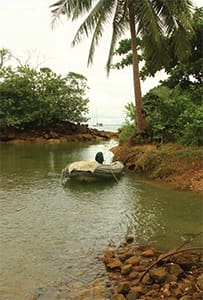To the editor: We had been anchoring on the southeast side of the Thailand tourist island of Koh Chang (Elephant Island), in the Gulf of Thailand. This is a desolate coast, no roads and only a few fishing boats passing by. All the tourists and activity are over the high mountains and rainforest, to be found on the West Coast. In fact, here on the southeast side we were the only cruising boat and had not seen another sailboat for weeks.
Today, for something to do, we decided to see where a local stream originated. The expats we asked, who live scattered around on Koh Chang, could not imagine the cove we described to them. Apparently, no westerner had explored this indentation of the coastline.
We had been using the fresh mountain water to fill our water tanks, do our laundry and get a good rinse in the quick current. This stream also had a long swimming hole, shaded by trees, just inland from where the stream collided with the ocean salt water. But where did all this fresh water come from and, most important, was there a waterfall with a swimming pool below it? We stuffed our backpacks with trekking food and jungle supplies, then set out on our mission of discovery.
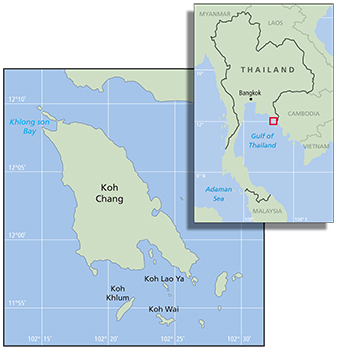 |
|
Patrick Childress was anchored on the uninhabited SE coast of Koh Chang in Thailand. |
The stream was wide and shallow. Our feet dragged and trudged as they fought with each step through the current. This trek called for special footing: closed-toe sandals that protect the feet but let the water and sand flush out. There was no way of knowing if our adventure would end within an hour or run into trouble and take all night.
The going was slow and wet and often difficult, especially when slippery rocks tried to trip us. At times, we marched to the bank and stepped out of the current. It seemed that spinning a machete to clear a path across land would be faster than the water route. In the areas along shore where the jungle was less dense and the ground more level, the machete whacked in constant motion like a gas-powered weed-whacker that followed the lead of a branch held in my other hand. This bushy-ended branch was constantly bobbing high and low and side to side to clear cobwebs and send jungle spiders scurrying. Still there were invisible strands that were left to wrap around my face that I had to spit out of my mouth. All the noise helped to alert long thin green snakes, fatter brown snakes, pythons, vipers, cobras and scorpions that something much bigger and heavier was coming through. Fortunately the serpents in the jungle were equally as afraid of us as we were of them. We have seen more snakes flattened on the paved roads than in the jungle.
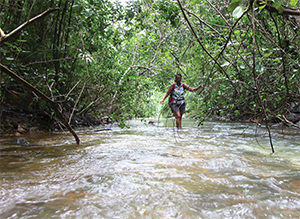 |
|
Rebecca heading upstream searching for a possible waterfall. |
|
Patrick Childress |
Surprisingly, there were few mosquitoes or flying insects to bother us. But just in case, we had carried high-concentrate DEET repellent and a small bottle of acetone. Acetone (fingernail polish remover) is very effective for stopping the itch of insect bites and for making those slimy strings of Velcro known as leeches drop from our skin. So far, in this part of the jungle, there were no signs of wild pigs, deer or monkeys, so there were no leeches. During the day, life in the jungle seemed sparse. At night however, anchored on our boat a quarter-mile offshore, the jungle was fully alive with the full range of sounds like a construction site: buzzing, whirring, banging, screeching, chipping, hammering. Certainly, in the jungle, they all come out at night!
We bushwhacked on, sometimes wading in to cross the stream again when the bank we were on became too steep and the opposite side looked flatter and more promising. At times, a land route was too difficult so the only option was to climb the stream through rapids and hope the ascent around a corner did not become unmanageable.
But we pressed on. An hour and a half of trekking quickly passed when we finally climbed to what we hoped to discover — not just a waterfall, but a double waterfall. It was certainly no Niagara Falls, but it was our own fun discovery complete with a pool at its bottom. No other tourist had seen this waterfall and certainly very few natives had been to this remote spot.
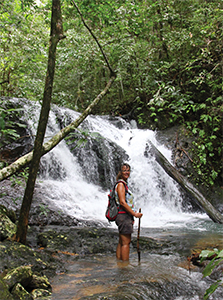 |
|
The waterfall located. |
|
Patrick Childress |
Our legs had lost much of their spring, so we took a long break and a swim. Eventually we forced movement upon ourselves and continued the climb upward.
The waterfall and adjoining rock face were too steep and slippery to climb so we moved downstream a bit, and then up the embankment. I hacked our way inland to circle around the waterfall and back to the stream. This was thick jungle. If you were to take a little stumble on the rocky terrain, you had to be careful which tree you reached out to for support. The wrong prop could give a hiker a handful of impalement on long spikes. There were other vines and vegetation that were a little less impaling but equally biting, and were always trying to scratch bare arms and legs. I now go jungle bushwhacking wearing a pair of gloves. Large toenail clippers are part of our jungle gear. They are used like surgical tweezers. Some of those bush spines are brittle and easily break when they are pulled, so they need to be dug out.
The stream led us to a torrent of water funneled into a narrow chute of vertical gray basalt. It was impassable. Once again it was back to hacking a trail up the mountain and circling back to the stream. Stepping in a hidden mass of large red ants, which swarmed my sandled feet, sent me into a wild hopping whoop. These ants hurt and leave terrible itching welts.
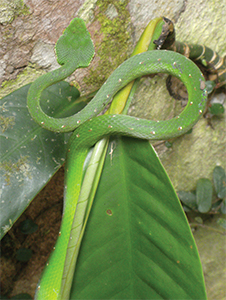 |
|
Be careful where you step. |
Soon the stream widened out again and we could climb up through the flow. We worked our way higher into a clearer sky far less shadowed by trees and vines. Our legs would not lift and move as easily as at the beginning of this adventure and we began to wonder how much more we should push this situation. The sun was well over the mountains and there were no more shadows. We were risking taking too long and being caught in the jungle after dark. It was a gamble, but we pressed on. With each step closer to the 1,200-foot summit, the main artery of the stream faded to one little gurgling of water sprouting magically from rocks. Just a little higher up, the small ravine was a dry bed that obviously in the past had carried torrents of water with a tropical downpour. But this was the end of the stream, the source of our adventure. We could turn around and race the fading light.
We slipped, skidded, braked and splashed down the middle of the stream, making good time and retracing our jungle trail around the narrow vertical chute. What had taken more than three and a half hours going up took an hour and a half to return. Our muscles were rubbery, we were wet and our feet hurt, but it was a fun day of adventure we will remember.
Now the problem is, what to do tomorrow?
—Patrick Childress is a professional captain with a 500-ton Master’s license. He and his wife Rebecca are in the ninth year of a circumnavigation aboard their Valiant 40 Brick House.

